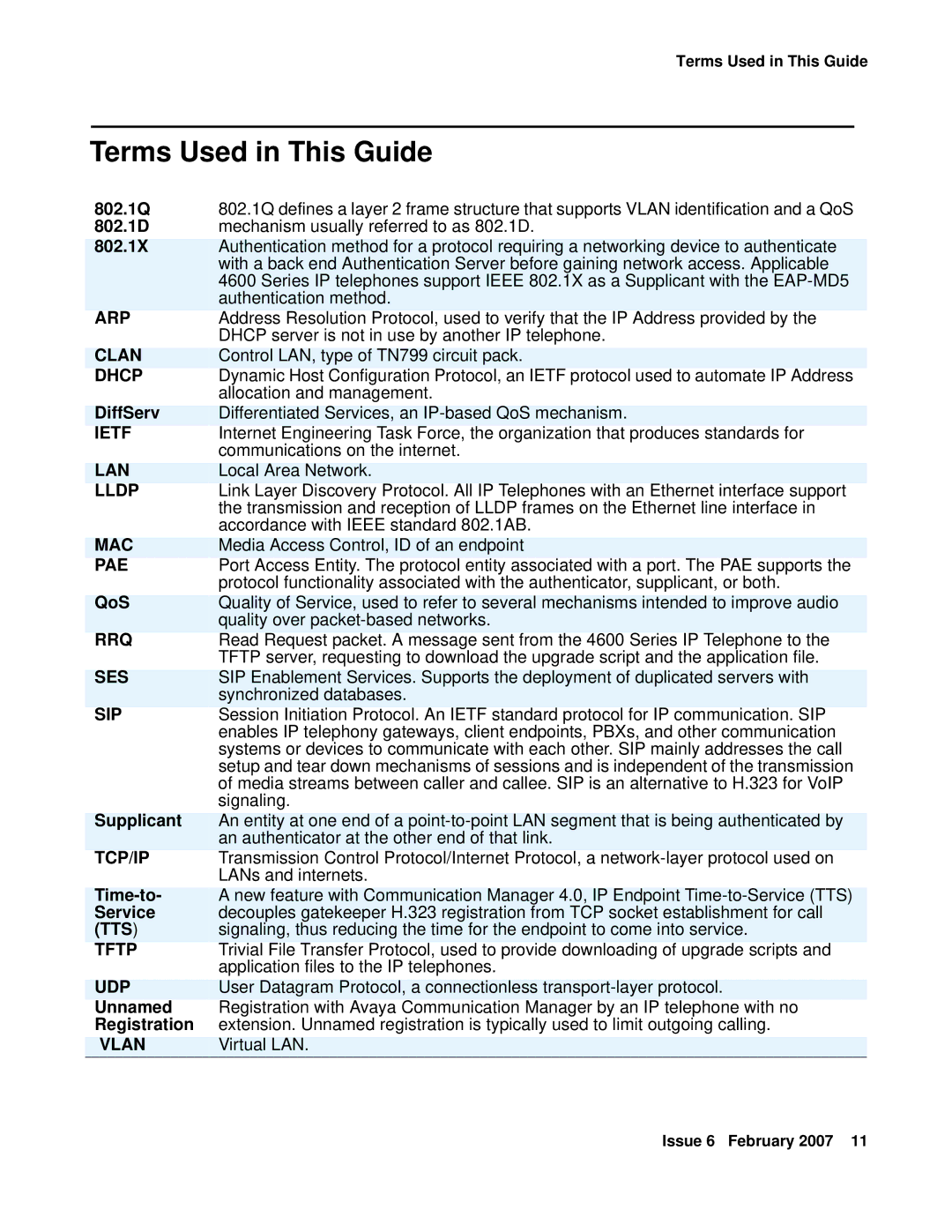
Terms Used in This Guide
Terms Used in This Guide
802.1Q | 802.1Q defines a layer 2 frame structure that supports VLAN identification and a QoS |
802.1D | mechanism usually referred to as 802.1D. |
| Authentication method for a protocol requiring a networking device to authenticate |
802.1X | |
| with a back end Authentication Server before gaining network access. Applicable |
| 4600 Series IP telephones support IEEE 802.1X as a Supplicant with the |
| authentication method. |
ARP | Address Resolution Protocol, used to verify that the IP Address provided by the |
| DHCP server is not in use by another IP telephone. |
| Control LAN, type of TN799 circuit pack. |
CLAN | |
DHCP | Dynamic Host Configuration Protocol, an IETF protocol used to automate IP Address |
| allocation and management. |
| Differentiated Services, an |
DiffServ | |
IETF | Internet Engineering Task Force, the organization that produces standards for |
| communications on the internet. |
| Local Area Network. |
LAN | |
LLDP | Link Layer Discovery Protocol. All IP Telephones with an Ethernet interface support |
| the transmission and reception of LLDP frames on the Ethernet line interface in |
| accordance with IEEE standard 802.1AB. |
| Media Access Control, ID of an endpoint |
MAC | |
PAE | Port Access Entity. The protocol entity associated with a port. The PAE supports the |
| protocol functionality associated with the authenticator, supplicant, or both. |
| Quality of Service, used to refer to several mechanisms intended to improve audio |
QoS | |
| quality over |
RRQ | Read Request packet. A message sent from the 4600 Series IP Telephone to the |
| TFTP server, requesting to download the upgrade script and the application file. |
| SIP Enablement Services. Supports the deployment of duplicated servers with |
SES | |
| synchronized databases. |
SIP | Session Initiation Protocol. An IETF standard protocol for IP communication. SIP |
| enables IP telephony gateways, client endpoints, PBXs, and other communication |
| systems or devices to communicate with each other. SIP mainly addresses the call |
| setup and tear down mechanisms of sessions and is independent of the transmission |
| of media streams between caller and callee. SIP is an alternative to H.323 for VoIP |
| signaling. |
| An entity at one end of a |
Supplicant | |
| an authenticator at the other end of that link. |
TCP/IP | Transmission Control Protocol/Internet Protocol, a |
| LANs and internets. |
| A new feature with Communication Manager 4.0, IP Endpoint |
Service | decouples gatekeeper H.323 registration from TCP socket establishment for call |
(TTS) | signaling, thus reducing the time for the endpoint to come into service. |
TFTP | Trivial File Transfer Protocol, used to provide downloading of upgrade scripts and |
| application files to the IP telephones. |
| User Datagram Protocol, a connectionless |
UDP | |
Unnamed | Registration with Avaya Communication Manager by an IP telephone with no |
Registration | extension. Unnamed registration is typically used to limit outgoing calling. |
| Virtual LAN. |
VLAN |
Issue 6 February 2007 11
